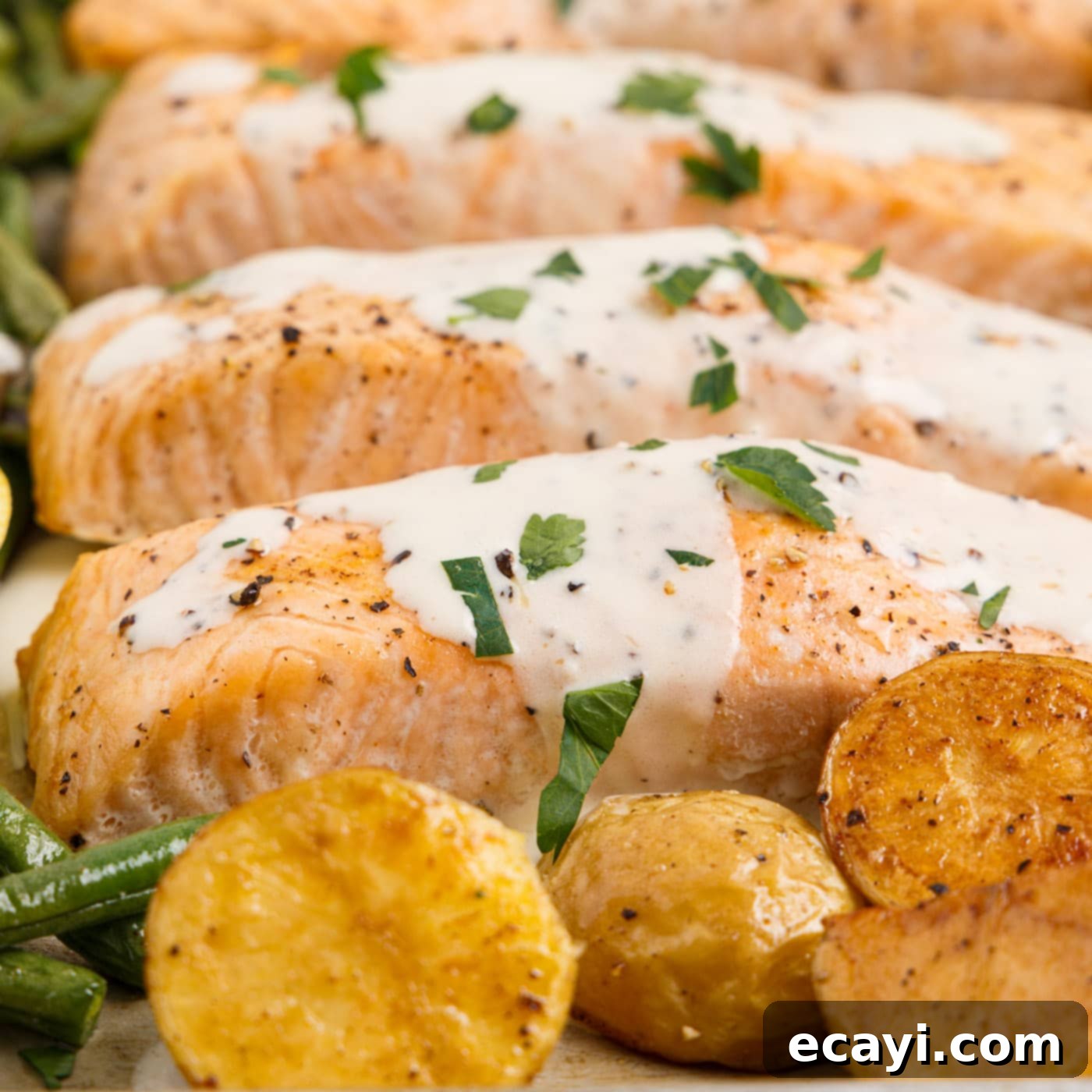Effortless Baked Salmon with Zesty Lemon Cream Sauce: Your Go-To Quick & Healthy Dinner
Prepare to elevate your weeknight dinner routine with this incredibly simple yet utterly delicious baked salmon recipe. Featuring perfectly flaky and tender salmon fillets crowned with a rich, vibrant lemon cream sauce, this dish promises a refreshing citrus zing that brightens every bite. What makes this recipe truly outstanding is its speed and ease – you can have a gourmet-quality meal on your table in under 25 minutes, making it ideal for busy evenings or when you crave something special without the fuss. It’s a healthy, flavorful, and impressively quick seafood solution that’s sure to become a family favorite.
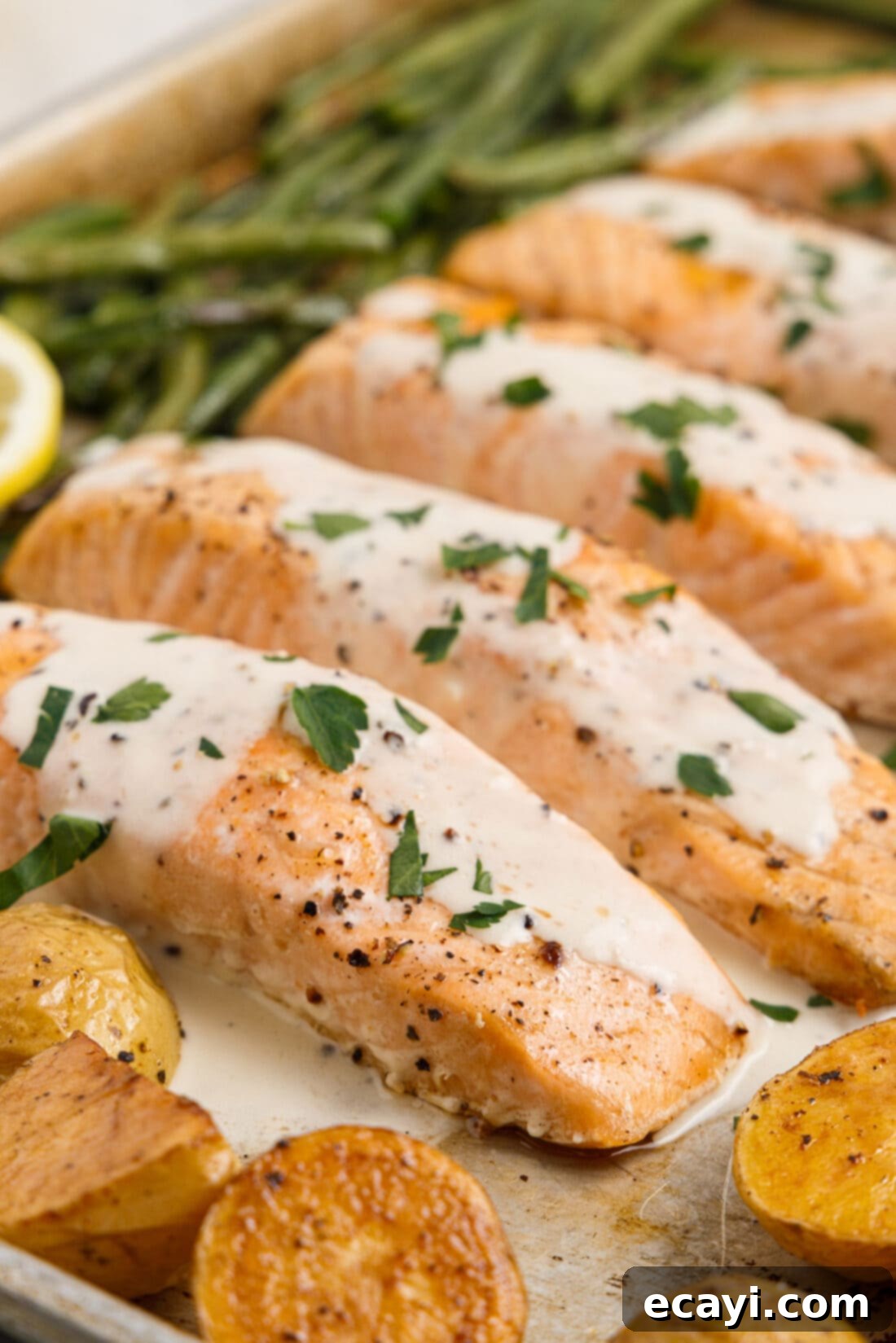
Why This Oven-Baked Salmon Recipe is a Must-Try
While there are countless ways to prepare salmon – from grilled salmon to pan-seared or poached salmon – our absolute favorite method for achieving a consistently delightful, flaky, and ultra-juicy result is by baking it in the oven. This technique ensures even cooking, locks in moisture, and minimizes cleanup, making it a stress-free option for any home cook. This particular baked salmon fillet recipe is not only bursting with flavor but also remarkably quick to prepare, showcasing a creamy yet surprisingly light lemon sauce that truly sets it apart.
The beauty of this recipe lies in its synergistic timing. The exquisite lemon cream sauce, with its perfect balance of richness and bright citrus notes, is designed to be prepared while your salmon bakes. This means you’re not spending extra time on separate components; everything comes together seamlessly within the 15-minute cooking window for the fish. The result is an incredibly quick meal that tastes like it took hours of effort. Oven baking also allows the salmon’s natural flavors to shine, complementing the sauce rather than overpowering it, ensuring a moist and tender texture every single time.
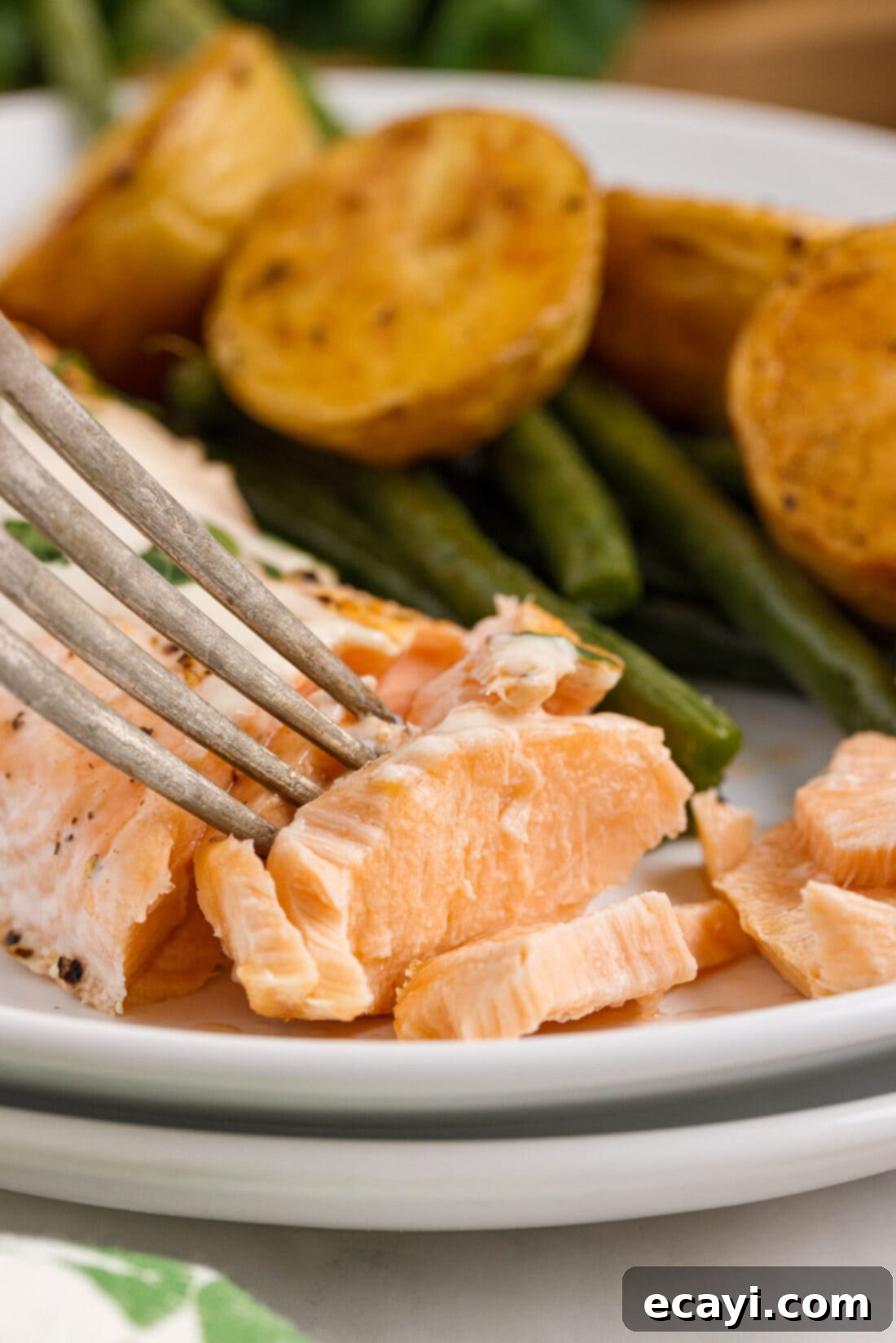
Key Ingredients for Your Delicious Baked Salmon
Crafting this quick and flavorful baked salmon with lemon cream sauce requires a handful of fresh, high-quality ingredients. Each component plays a crucial role in developing the rich flavor and perfect texture of this dish. For a complete list of all precise measurements, ingredients, and detailed instructions, please refer to the printable recipe card located at the end of this post.
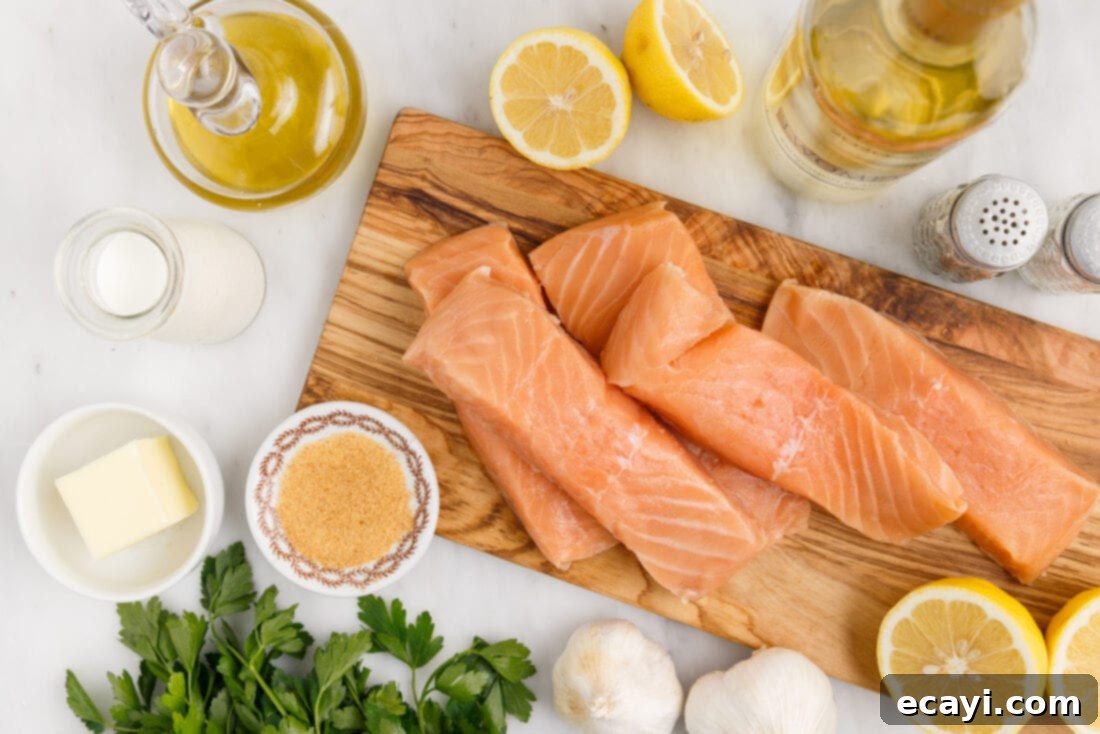
Ingredient Spotlight & Smart Substitutions
Understanding your ingredients is key to culinary success and allows for flexibility. Here’s a deeper dive into the main components of this baked salmon recipe:
SALMON – The star of our dish! Achieving that perfectly flaky, moist, and utterly delicious salmon is all about precise cooking temperature. Salmon, especially individual fillets, can quickly become dry and less enjoyable if overcooked. We highly recommend using an instant-read thermometer to check for doneness; aim for an internal temperature of 135°F (57°C) at the thickest part. The salmon will continue to cook slightly after removal from the oven (carry-over cooking), reaching the ideal 140-145°F (60-63°C). Remember that the size and thickness of your fillets will influence baking time, so always rely on temperature rather than just time. For the best results, opt for fresh, high-quality salmon fillets, either skin-on or skin-off depending on your preference. Skin-on salmon tends to stay moister and is easier to handle on the baking sheet.
LEMON CREAM SAUCE – This sauce is truly the crowning glory of this baked salmon. It’s wonderfully rich and creamy, yet the bright acidity from the fresh lemon juice ensures it remains light and refreshing, cutting through the richness of the salmon beautifully. It’s loaded with aromatic flavors that perfectly complement the fish. For an extra layer of savory depth, you can sauté finely diced shallots along with, or as an alternative to, the garlic. We’ve chosen a Sauvignon Blanc for its crisp, dry profile, which works exceptionally well in this recipe, adding a subtle complexity. However, if you prefer not to use alcohol or don’t have white wine on hand, a good quality chicken stock or broth makes an excellent substitute, providing a similar savory base without compromising flavor. You can also experiment with other dry white wines like Pinot Grigio or Chardonnay.
Step-by-Step Guide: Crafting Your Baked Salmon with Lemon Cream Sauce
These step-by-step photos and instructions are here to help you visualize how to make this delightful recipe. For the complete printable version of this recipe, including exact measurements and instructions, you can easily Jump to Recipe at the bottom of this page.
- Prepare the Salmon: Begin by preheating your oven to a hot 450°F (232°C). This high temperature is key to achieving that beautiful crust and perfectly cooked interior. Carefully rinse your salmon fillets under cold water and then, crucially, pat them thoroughly dry with paper towels. Removing excess moisture helps the salmon skin (if present) crisp up and ensures a better sear and flavor. Arrange each fillet 1-2 inches apart on a parchment paper-lined baking sheet. Parchment paper prevents sticking and makes cleanup a breeze.
- Season the Salmon: Drizzle olive oil evenly over all the salmon fillets. Use your fingers to gently rub the oil around, ensuring each fillet is lightly coated. This helps the seasonings adhere and promotes a golden-brown finish.
- Add Flavor: Generously sprinkle ground black pepper and seasoned salt over the salmon fillets. Don’t be shy with the seasoning, as it truly enhances the salmon’s natural flavor. Feel free to experiment with other complementary seasonings like paprika for color and a touch of sweetness, garlic powder for added savory depth, or fresh or dried dill, which is a classic pairing with salmon.
- Bake to Perfection: Place the seasoned salmon in your preheated oven and bake for 12-15 minutes. The precise timing will depend on the thickness of your fillets. The critical indicator of doneness is when the thickest part of the salmon registers 135°F (57°C) on an instant-read thermometer. This internal temperature ensures a moist, tender, and flaky result. Once cooked, remove the salmon from the oven and let it rest for 5 minutes. This resting period allows the juices to redistribute, resulting in even juicier fish.
- Start the Lemon Cream Sauce: While your salmon is baking, begin preparing the delightful lemon cream sauce. Melt about 1 tablespoon of unsalted butter in a heavy-bottomed saucepan over medium heat. A heavy-bottomed pan ensures even heating and prevents scorching.
- Infuse Aromatics: Add the minced garlic to the melted butter and sauté for approximately 30 seconds, or until it becomes wonderfully fragrant. Be careful not to burn the garlic. Next, pour in the dry white wine (or chicken stock, if you’re using a non-alcoholic alternative). Bring the mixture to a gentle simmer and let it reduce for about 2-3 minutes, or until the liquid has reduced to roughly half its original volume. This step concentrates the flavors.
- Finish the Sauce: Cut the remaining unsalted butter into small pieces and whisk them into the reduced sauce until fully incorporated, creating a rich base. Stir in the fresh lemon juice (the juice of about one medium lemon) and the heavy cream. Continue to simmer for an additional 3-4 minutes, whisking constantly. This consistent whisking helps the sauce thicken evenly and prevents it from separating. The sauce is ready when it’s thick enough to generously coat the back of a spoon. Taste and adjust seasoning with salt and pepper as desired, ensuring a perfect balance of creamy, tangy, and savory flavors.
- Serve & Garnish: Once both the salmon and sauce are ready, pour the warm lemon cream sauce generously over your beautifully baked salmon fillets. Finish with a sprinkle of fresh chopped parsley for a burst of color and a fresh herbaceous note. Serve immediately and enjoy!
Frequently Asked Questions & Expert Tips for Perfect Salmon
Leftover baked salmon and lemon cream sauce can be stored together in an airtight container in the refrigerator for up to 2 days. For best quality, consume within 24 hours.
Absolutely, you can use frozen salmon for this recipe! While I always recommend thawing salmon overnight in the refrigerator for optimal texture, you can certainly bake salmon straight from the freezer if time is short. If cooking from frozen, first rinse the fillets under cool water to remove any ice crystals. It’s best to hold off on adding the seasonings and olive oil until the salmon has lightly cooked and softened in the oven (typically about 5-7 minutes). Once slightly softened, remove from the oven, add your oil and seasonings, and then return to bake until done. Keep in mind that cooking from frozen will require additional baking time, possibly adding another 5-10 minutes. Always check the internal temperature with a meat thermometer; it should reach 135°F (57°C) at its thickest point for a perfectly cooked result.
King (Chinook), Sockeye, Coho, and Atlantic salmon are all excellent choices for baking. Each has a slightly different fat content and flavor profile. King salmon is often prized for its rich, buttery flavor and high fat content, making it very forgiving to cook. Sockeye has a deeper red color and firmer texture, while Coho is milder. Atlantic salmon (often farmed) is widely available and has a consistently good flavor and texture. Choose what’s fresh and available to you.
The best way to prevent overcooking is to use an instant-read thermometer and remove the salmon from the oven when it reaches 135°F (57°C). Also, ensure your fillets are of similar thickness for even cooking. Overcooked salmon becomes dry and tough, so pulling it out just before it reaches its final desired temperature (140-145°F or 60-63°C) accounts for carry-over cooking.
Yes, you can prepare the lemon cream sauce up to a day in advance. Store it in an airtight container in the refrigerator. When ready to serve, gently reheat it over low heat, whisking frequently. If it’s too thick, you can add a splash of chicken stock or cream to thin it out to your desired consistency.
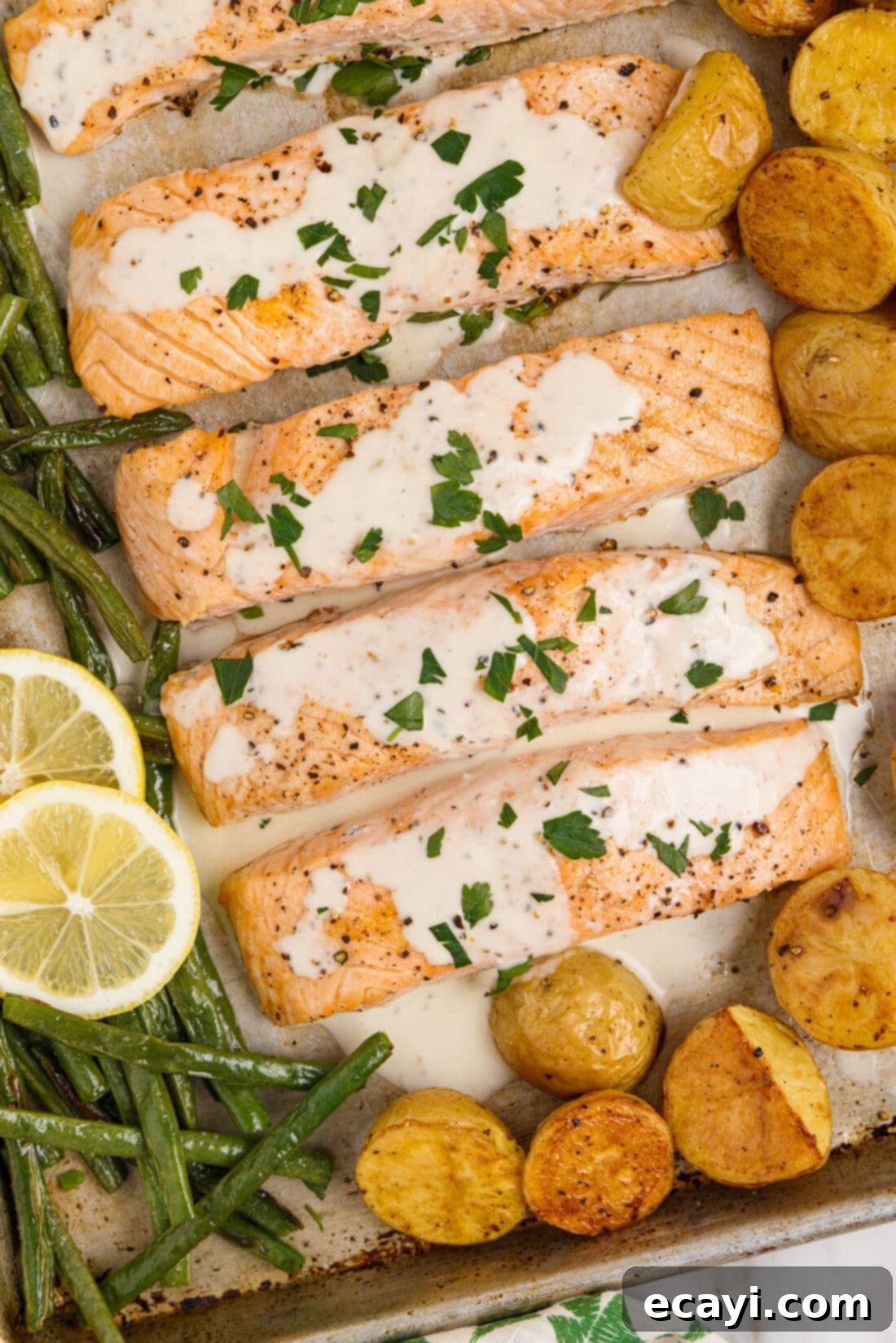
Delightful Serving Suggestions
This baked salmon with lemon cream sauce is a versatile dish that pairs beautifully with a wide array of side dishes, allowing you to create a complete and satisfying meal. For a wholesome and balanced plate, consider serving it alongside vibrant roasted vegetables like crisp green beans, tender asparagus spears, hearty roast potatoes, steamed broccoli florets, or sweet potato wedges. A fresh, crisp side salad with a light vinaigrette also provides a wonderful counterpoint to the rich sauce. For a more indulgent meal, creamy mashed potatoes or a delicate risotto would be fantastic. Leftovers, if you’re lucky enough to have any, can be flaked and mixed into leafy green salads for a healthy lunch, or tossed with pasta for a quick and flavorful second-day meal.
Explore More Seafood Delights
If you’re a fan of fish and looking for more quick, easy, and flavorful seafood recipes, you’ve come to the right place! Here are some other fantastic salmon and fish dishes to inspire your next meal:
- Hearty Fish Chowder
- Zesty Salmon Tacos
- Flavorful Skillet Broiled Cod
- Elegant Poached Salmon
- Easy Sheet Pan Salmon Dinner
- Tangy Dijon Lemon Caper Salmon
- Sweet & Savory Maple Soy Salmon
I’m passionate about baking and cooking, and I love sharing my kitchen adventures with all of you! To make sure you never miss a new recipe, I offer a convenient newsletter delivered straight to your inbox every time a new post goes live. Simply subscribe here and start receiving your free daily recipes!
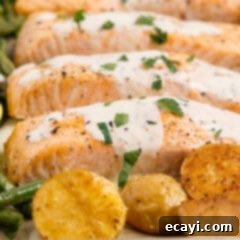
Baked Salmon with Lemon Cream Sauce
IMPORTANT – Don’t forget to check the Frequently Asked Questions and Expert Tips section within the blog post above for additional helpful insights and guidance. Simply scroll back up to read them!
Print It
Pin It
Rate It
Save ItSaved!
Ingredients
- 48 oz salmon fillets 6 – 8 oz fillets, skin-on or skin-off
- 2 Tbsp olive oil 1-2 Tbsp, for coating salmon
- 1 tsp ground black pepper
- 1 tsp seasoned salt
- 4 Tbsp unsalted butter divided, for the sauce
- 3 cloves garlic minced (or 1-2 shallots, finely diced)
- ½ cup dry white wine e.g., Sauvignon Blanc, or chicken stock
- 2 Tbsp lemon juice freshly squeezed, from about 1 lemon
- ⅓ cup heavy whipping cream
- fresh chopped parsley for garnish (optional)
Things You’ll Need
-
Baking sheet
-
Meat thermometer
-
Saucepan
Before You Begin & Recipe Notes
- For a complete meal, consider roasting vegetables or potatoes alongside your salmon. If you choose green beans or asparagus, they often cook in a similar timeframe to salmon on a separate sheet pan. Heartier vegetables like carrots or potatoes will require significantly more time, so plan their start accordingly to ensure everything finishes at once.
- The recipe recommends a dry white wine like Sauvignon Blanc for the sauce due to its crisp flavor profile. If you prefer not to use wine, a high-quality chicken stock or broth is an excellent non-alcoholic substitute that will still provide a delicious depth of flavor.
- Store any leftover baked salmon and sauce in an airtight container in the refrigerator for up to 2 days for optimal freshness.
- Always pat your salmon fillets thoroughly dry before seasoning and baking. This crucial step helps create a delicious, slightly crispy exterior and prevents the fish from steaming, ensuring a perfectly flaky texture.
- Don’t overcrowd your baking sheet. Giving each salmon fillet enough space (1-2 inches apart) allows for proper air circulation, which is essential for even cooking and a beautiful finish.
Instructions
-
Preheat oven to 450°F (232°C). Rinse salmon fillets and pat thoroughly dry with paper towels. Arrange each fillet 1-2 inches apart on a parchment paper-lined sheet pan.
-
Drizzle olive oil over the salmon and use your fingers to rub it around to coat the salmon fillets evenly.
-
Sprinkle ground black pepper and seasoned salt over the salmon fillets. Feel free to add other desired seasonings like paprika, garlic powder, or dill.
-
Bake the salmon for 12-15 minutes, or until the thickest part of the salmon registers 135°F (57°C) on an instant-read thermometer. Remove from the oven and let sit for 5 minutes to allow for carry-over cooking and juice redistribution.
-
While the fillets cook, begin making the lemon cream sauce. Melt about 1 tablespoon of the unsalted butter in a heavy-bottomed saucepan over medium heat.
-
Add the minced garlic (or diced shallots) and sauté for about 30 seconds until fragrant. Pour in the dry white wine (or chicken stock) and simmer for about 2-3 minutes, or until the sauce has reduced to half the original amount.
-
Cut the remaining butter into pieces and whisk them into the sauce until smooth. Add the fresh lemon juice and heavy cream. Simmer for about 3-4 additional minutes, whisking constantly, until the sauce thickens enough to coat the back of a spoon. Season with salt and pepper to taste.
-
Pour the warm lemon cream sauce generously over the salmon fillets. Garnish with fresh chopped parsley, if desired, and serve immediately.
Nutrition Information
The recipes on this blog are tested with a conventional gas oven and gas stovetop. It’s important to note that some ovens, especially as they age, can cook and bake inconsistently. Using an inexpensive oven thermometer can assure you that your oven is truly heating to the proper temperature. If you use a toaster oven or countertop oven, please keep in mind that they may not distribute heat the same as a conventional full-sized oven, and you may need to adjust your cooking/baking times. In the case of recipes made with a pressure cooker, air fryer, slow cooker, or other appliance, a link to the appliances we use is listed within each respective recipe. For baking recipes where measurements are given by weight, please note that results may not be the same if cups are used instead, and we can’t guarantee success with that method.
